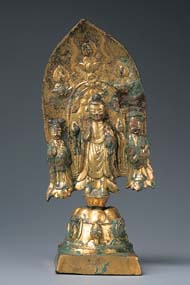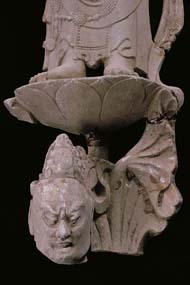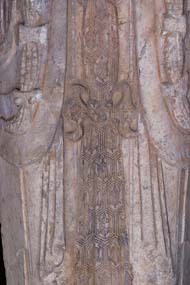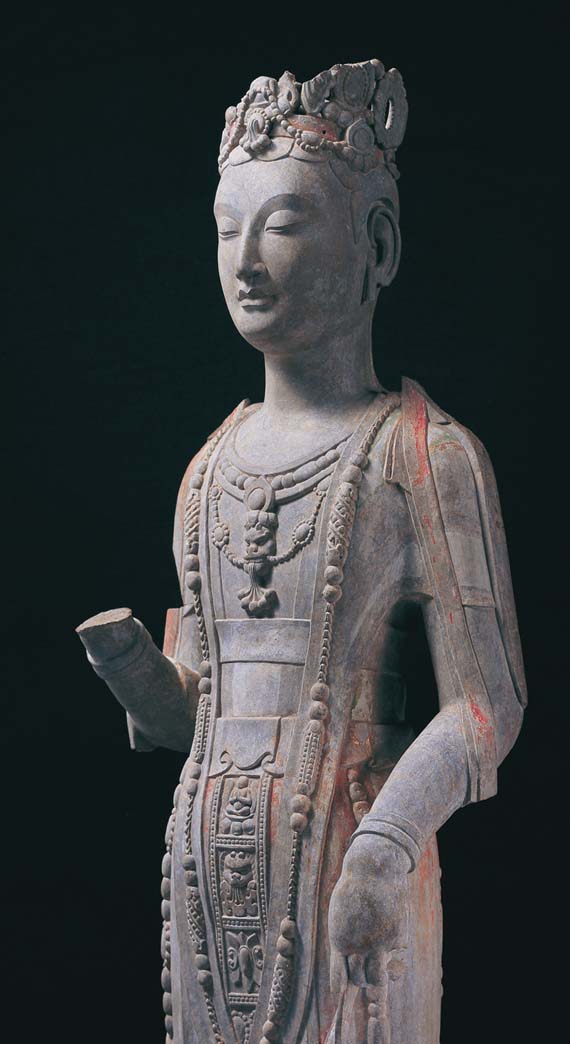
fig. 4

This section examines the Chinese influence on Japanese Buddhist images from
the Asuka period (538–710) through a number of exhibited works. The
Standing Bodhisattva, excavated in Bo’xing County (see cover
and back cover pages), shows stylistic features of late Northern Wei-dynasty
images, such as long hair with upturned curls flowing over both shoulders, a
stole that crosses in an X-shape in front of the figure's abdomen, and lower
his area slightly protruding forward. The elegant eyebrows, slightly
upturned almond-shaped eyes, and archaic smile also resemble that of the
Nara temple Hōryūji’s
Guze Kannon.

Another image on display is the gilt bronze Śākyamuni Triad (fig. 4), which has an inscription dating to Tianbao 7 (556) of the Northern Qi dynasty and is owned by the Shandong Provincial Museum. This sculpture, while small, has a relatively large boat-shaped mandorla that fits behind all three images. The treatment of the robe hems and stole ends that fan out to the right and left and the boxy drapery folds are reminiscent of Śākyamuni Triad in Hōryūji’s Main Hall. The head of the fragmentary guardian figure at the foot of Anqiu Municipal Museum’s Standing Bodhisattva (fig. 5) is also similar to the Kongō gigaku mask (among the treasures dedicated to Hōryūji), which is said to have been introduced to Japan by the Paekche artist Mimashi in the twentieth year of Empress Suiko’s reign (612).


Another interesting discovery in this exhibition is the use of cut gold technique, known as kirikane in Japanese, on a fragmentary bodhisattva statue (fig. 6). The incorporation of finely cut gold leaf for the triple layered linked tortoiseshell motif of the decorative sash on this image─excavated from the temple Longxingsi in Qingzhou and dating to the Northern Qi dynasty─confirms the Chinese origin of this technique. Cut gold leaf can also be seen on Hōryūji’s celebrated Tamamushi zushi shrine and the Main Hall’s Four Heavenly Kings.

The three bodhisattvas with cicada-ornamented crowns will be exhibited at MIHO MUSEUM until December 2007 after the closing of the special exhibition.
Another image on display is the gilt bronze Śākyamuni Triad (fig. 4), which has an inscription dating to Tianbao 7 (556) of the Northern Qi dynasty and is owned by the Shandong Provincial Museum. This sculpture, while small, has a relatively large boat-shaped mandorla that fits behind all three images. The treatment of the robe hems and stole ends that fan out to the right and left and the boxy drapery folds are reminiscent of Śākyamuni Triad in Hōryūji’s Main Hall. The head of the fragmentary guardian figure at the foot of Anqiu Municipal Museum’s Standing Bodhisattva (fig. 5) is also similar to the Kongō gigaku mask (among the treasures dedicated to Hōryūji), which is said to have been introduced to Japan by the Paekche artist Mimashi in the twentieth year of Empress Suiko’s reign (612).

Another interesting discovery in this exhibition is the use of cut gold technique, known as kirikane in Japanese, on a fragmentary bodhisattva statue (fig. 6). The incorporation of finely cut gold leaf for the triple layered linked tortoiseshell motif of the decorative sash on this image─excavated from the temple Longxingsi in Qingzhou and dating to the Northern Qi dynasty─confirms the Chinese origin of this technique. Cut gold leaf can also be seen on Hōryūji’s celebrated Tamamushi zushi shrine and the Main Hall’s Four Heavenly Kings.
The three bodhisattvas with cicada-ornamented crowns will be exhibited at MIHO MUSEUM until December 2007 after the closing of the special exhibition.
| List of Plates |
|
| Cover page | Standing Bodhisattva Northern to Eastern Wei dynasty Shandong Province |
| Fig. 1 | Śākyamuni Triad (detail) Eastern Wei dynasty, Tianping 3 (536) Qingzhou Municipal Museum |
| Fig. 2 | Gold Cicada Ornament Eastern Jin dynasty, 4th–5th century Excavated from Xian Heguan Gao Song tomb, Nanking |
| Fig. 3 | Standing Bodhisattva Eastern Wei dynasty Qingzhou Municipal Museum |
| Fig. 4 | Buddha Triad Northern Qi dynasty, Tianbao 7 (556) Shandong Provincial Museum |
| Fig. 5 | Standing Bodhisattva (detail) Northern Qi dynasty Anqiu Municipal Museum |
| Fig. 6 | Fragment of Bodhisattva (detail) Northern Qi dynasty Qingzhou Municipal Museum |
| Fig. 7 | Standing Bodhisattva Northern Qi dynasty Qingzhou Municipal Museum |
Photographs by Kenji Yamazaki. |
|

fig. 5

fig. 6

fig. 7